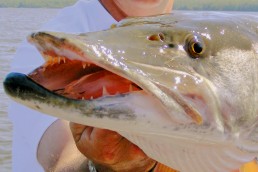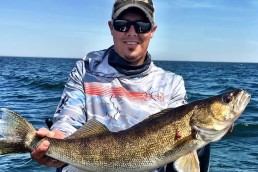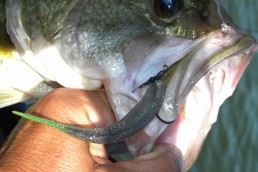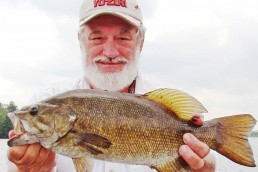Tick and Click your way to more Tough-bite Muskies
SHARE THIS POST
This past July, Chas Martin and I were on our annual early-summer filming trip to Lake of the Woods. While we consistently scored on muskies every day and were building a good film library throughout the trip for 2017’s Fishing With Joe Bucher TV, strong winds and bad weather were a factor.
Chas and I located a reef containing an entire wolf pack of muskies, and we consistently raised various- sized fish from one spot. In particular, one fish stood out from the rest as the true alpha muskie of the pack— she would show herself again and again in a lazy follow behind a GlideRaider. Yet no matter how many times we returned and no matter how many different lures we threw her way, the fish we nicknamed “Lazy Lenny” wouldn’t commit to the strike.
It should come as no surprise that I suggested that we return to this fish on the last light. Just like clockwork, we returned as light began to wane. I couldn’t blame Chas for throwing the same GR (GlideRaider) on “Lenny” one more time. I started out with a small Buchertail, but after a few casts my gut told me to once again dig out a trusty old ShallowRaider crankbait so I could “tick and click” the lure tighter to the deep rocks. After only a couple of casts, I felt the lure tick a higher-cresting boulder.
“Ticking rocks,” I said to Chas. “This is where she ought to be.”
A few more turns of the reel handle, and my rod doubled. I knew immediately that I had connected with “Lazy Lenny.” As it turns out, this was my biggest fish of that trip. The tick and click trick worked yet again and had saved my trip.
As the calendar turned to August, hopes of a blazing blade bite and torrid, topwater tango quickly faded as my partner, former University of Wisconsin Badger linebacker, Chris Ghidorzi, and I struggled to even get a follow, much less a strike. Our daily score of one muskie on camera wasn’t what we expected, and a shift in our game plan became painfully obvious in the shoulders after a few days.
Once again, I suggested we keep a crankbait wet on every spot for a few hours to see if our luck would change. Using some appropriate football analogies, we “broke the huddle” on our first spot with the new strategy in place—it was agreed that either of us would always be running a crankbait no matter what the other angler threw.
It only took a few casts for us to “score a touchdown” and confirm we had hit pay dirt when the big linebacker grunted, “Fish Joe!” and his rod had doubled.
Chris battled the brute back and forth around the bow of the boat. The exuberance over such immediate success made us both giggle. A well-hooked 47-incher of a tank eventually found its way into my landing net. It was Chris’ best fish of the trip.
Are you enjoying this post?
You can be among the first to get the latest info on where to go, what to use and how to use it!
In the next four days, most of our muskies fell to this same lure and technique, including my top muskie of the season, which I plan to write about in the next issue.
Now, let’s move on to the actual “X’s and O’s” of this technique and examine why it’s so effective.
Muskie anglers use running baits high, fast and clean in the spinner, and jerkbait and topwater users tend to employ crankbaits in the same manner. Instead, I use crankbaits in a completely different way and urge you to do the same. In a nutshell, turn your crankbait into a double-purpose weapon. The first goal is to catch a fish with it, but the second one is to utilize it as side-scanning sonar.
I choose a crankbait that runs a certain depth I want to attain. I then use it to seek out the location of high spots, a hard bottom, weed extensions or any other form of cover that might hold a tight, deep-cover fish. While I’m mapping out the configuration of a spot, I’m also presenting a highly attractive lure and technique to all species.
As my crankbait goes clicking along, it occasionally ticks the bottom or weeds, wood or other submerged debris. Sometimes a muskie is hovering tight to such structure elements and then it’s fish on! I repeatedly find great offshore spots and learn more and more about the unique contours and configurations of these individual areas while occasionally scoring on big fish in the process. This timeless technique has worked well for me since I was a teenager and continues to save trips and even seasons for me in this day and age.
While all kinds of crankbaits have the potential to work with this technique, floating divers are generally preferred since they often track nose-down, tail-up. This enables them to bump and rise their way through cover and bottom obstructions with minimal hang-ups. It’s also key to choose a crankbait that runs at a depth range that’s conducive to the structure you’re fishing, and the depth at which the fish are holding. In other words, a deep-diver might not always be the best choice. A mid-depth runner or even a shallow traveler is likely to do the job better depending upon the situation.
The tick and click crankbait trick has worked for me for all species of gamefish for decades. Unsurprisingly, I finished the season filming with Chas Martin on a cold and rainy afternoon in mid-October with the same tactics. While Chas bombed his big-glide baits all over the place in search of a coldwater trophy, I launched repeated casts ahead of the boat, seeking out deep-rock projections and sunken woody cover with my jointed DepthRaider.
As we moved along a wave-pounded, steep, sloping bank, I felt the rhythmic click of my DepthRaider get interrupted by a collision with a submerged cedar tree. Backing off on my retrieve for an instant allowed the lure to momentarily float upward out of the woody snag. Then I resumed my retrieve in a more cautious manner and could feel the diving lip tick the various branches. As soon as it felt like the lure was in the clear, I picked up speed slightly, and pow! Another muskie tricked by this same technique.
MWO
SHARE THIS POST
Did you enjoy this post?
You can be among the first to get the latest info on where to go, what to use and how to use it!
Joe Bucher
Joe Bucher is a Freshwater Fishing Hall of Fame Legendary Angler, book author, lure designer and host of Fishing with Joe Bucher TV series.



